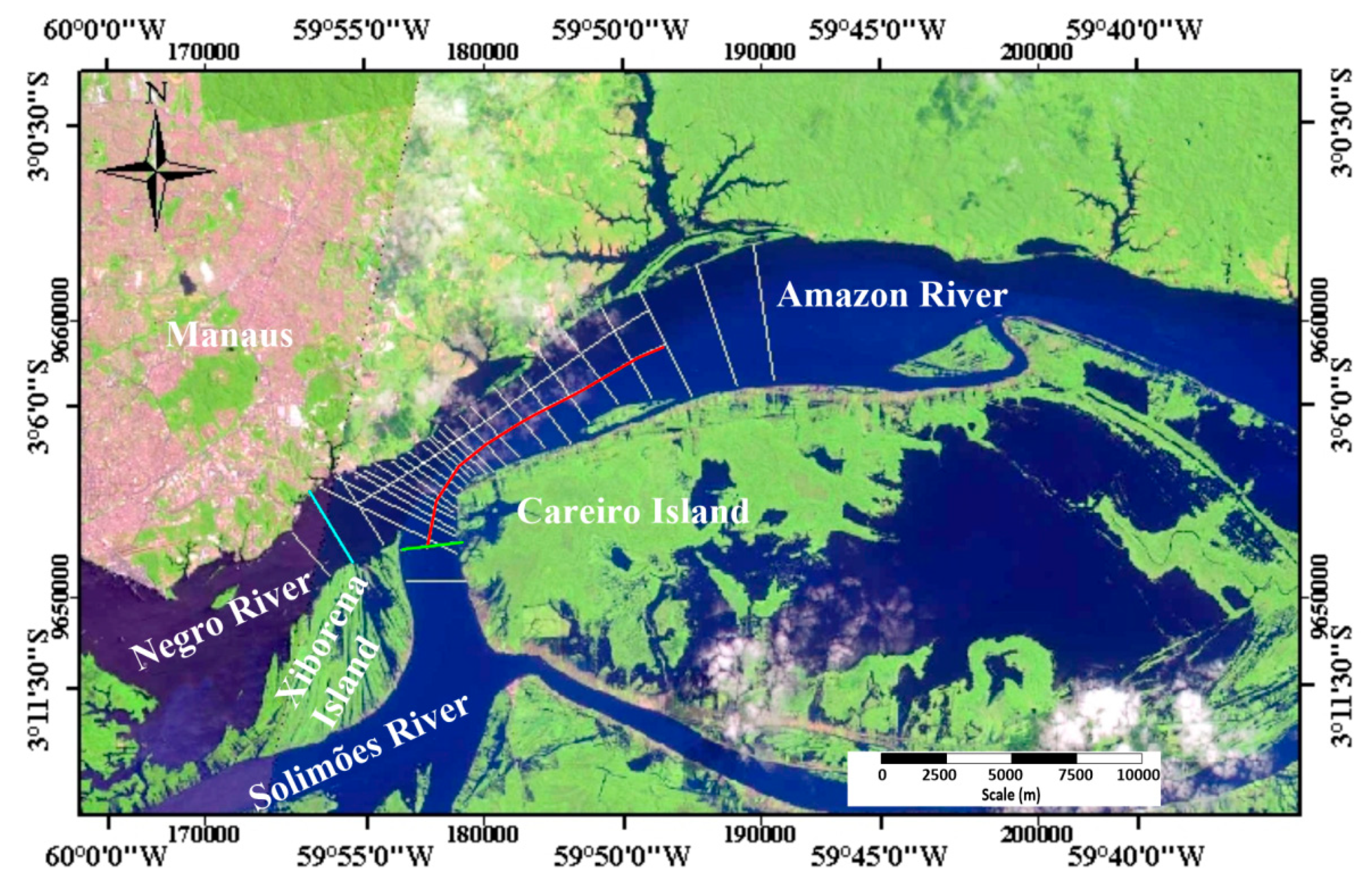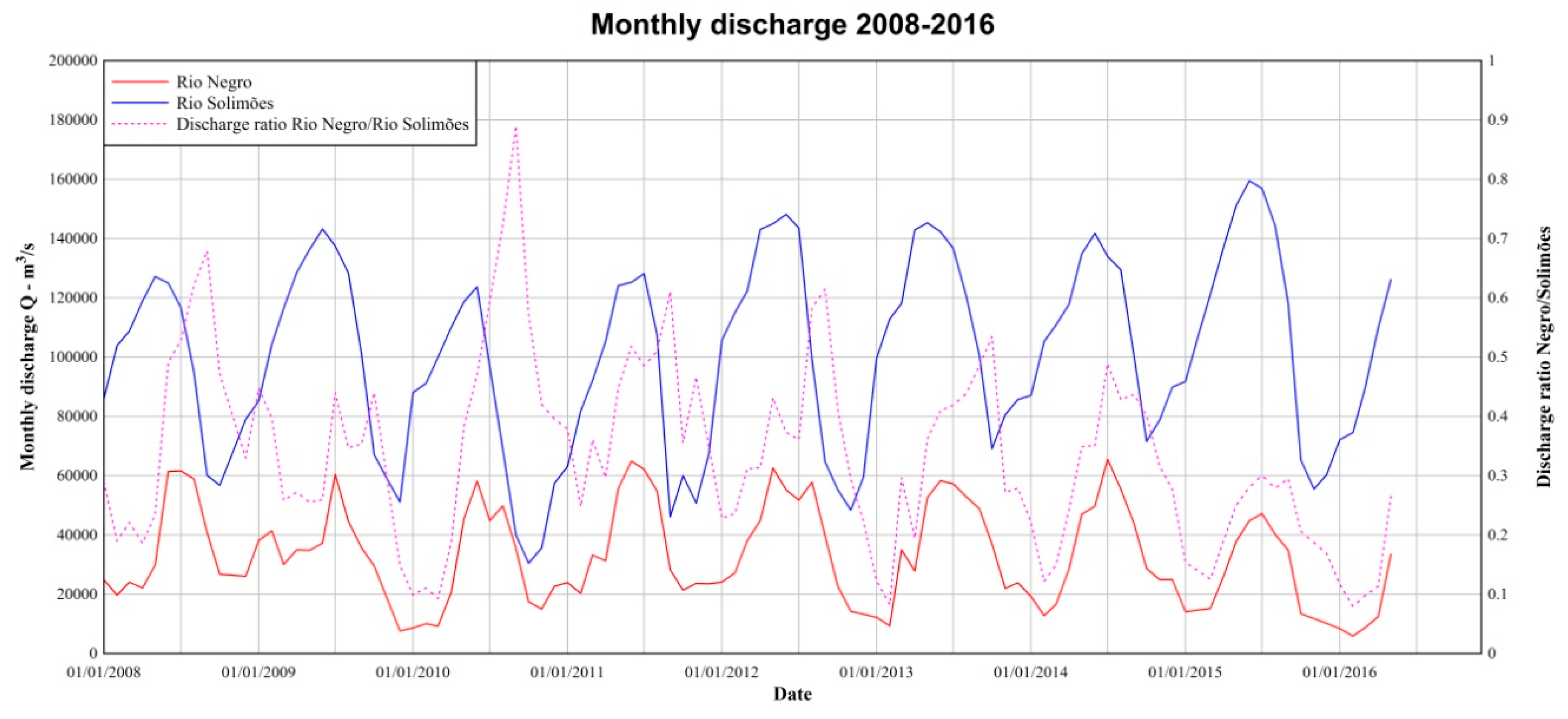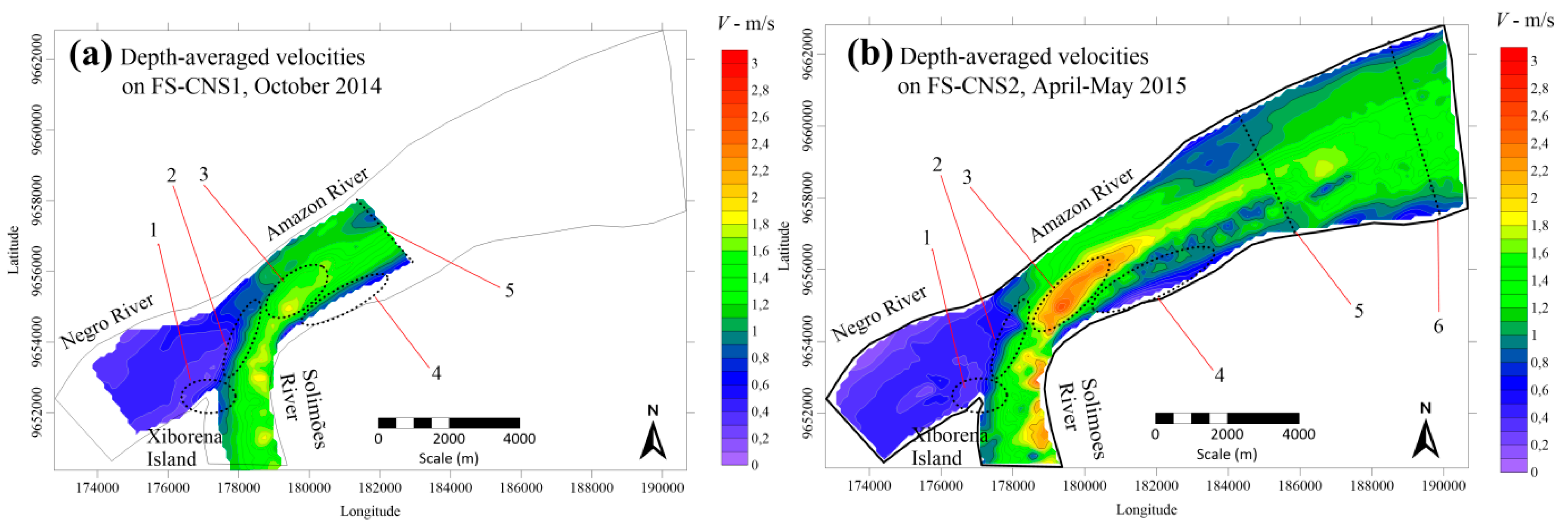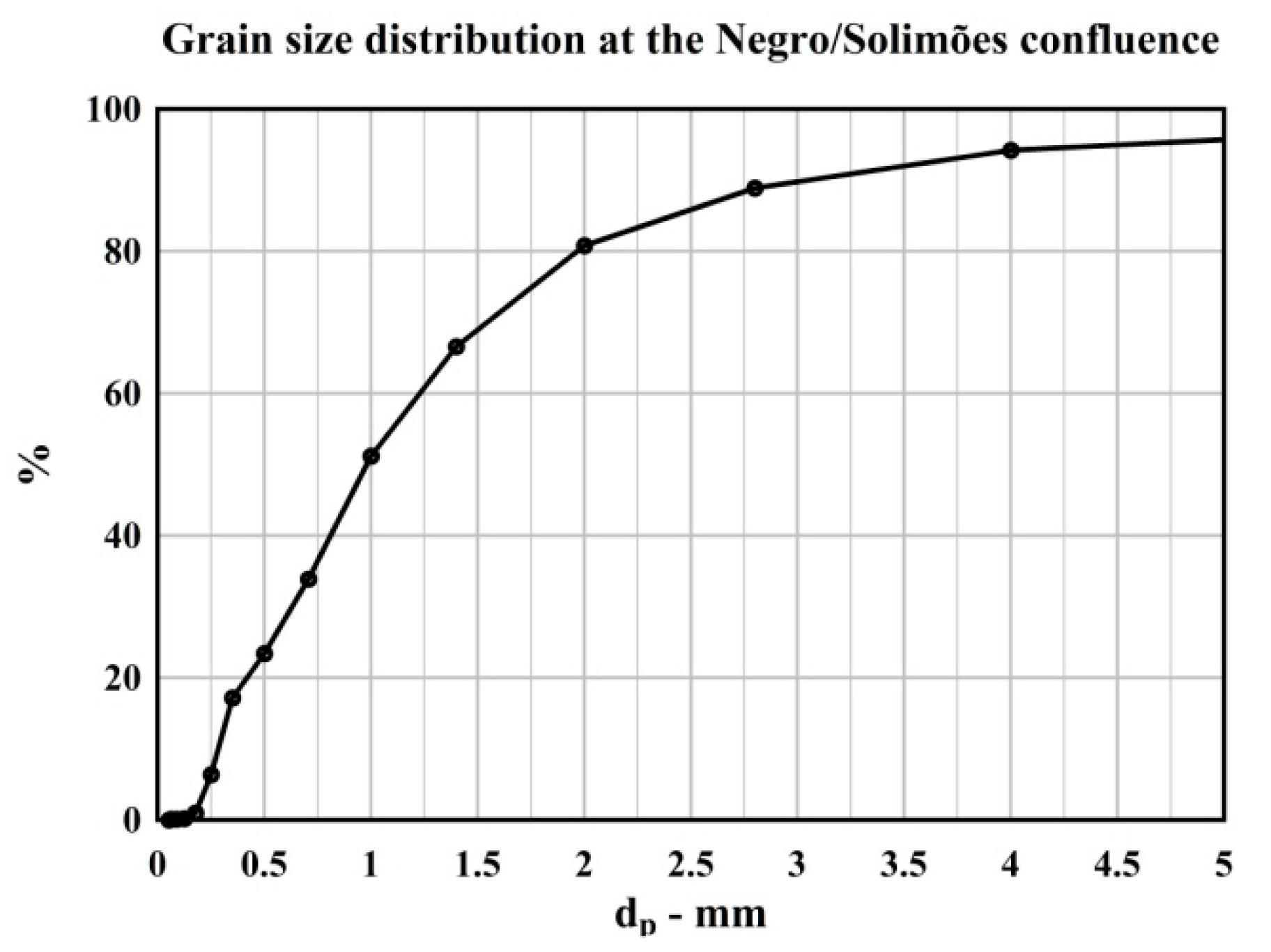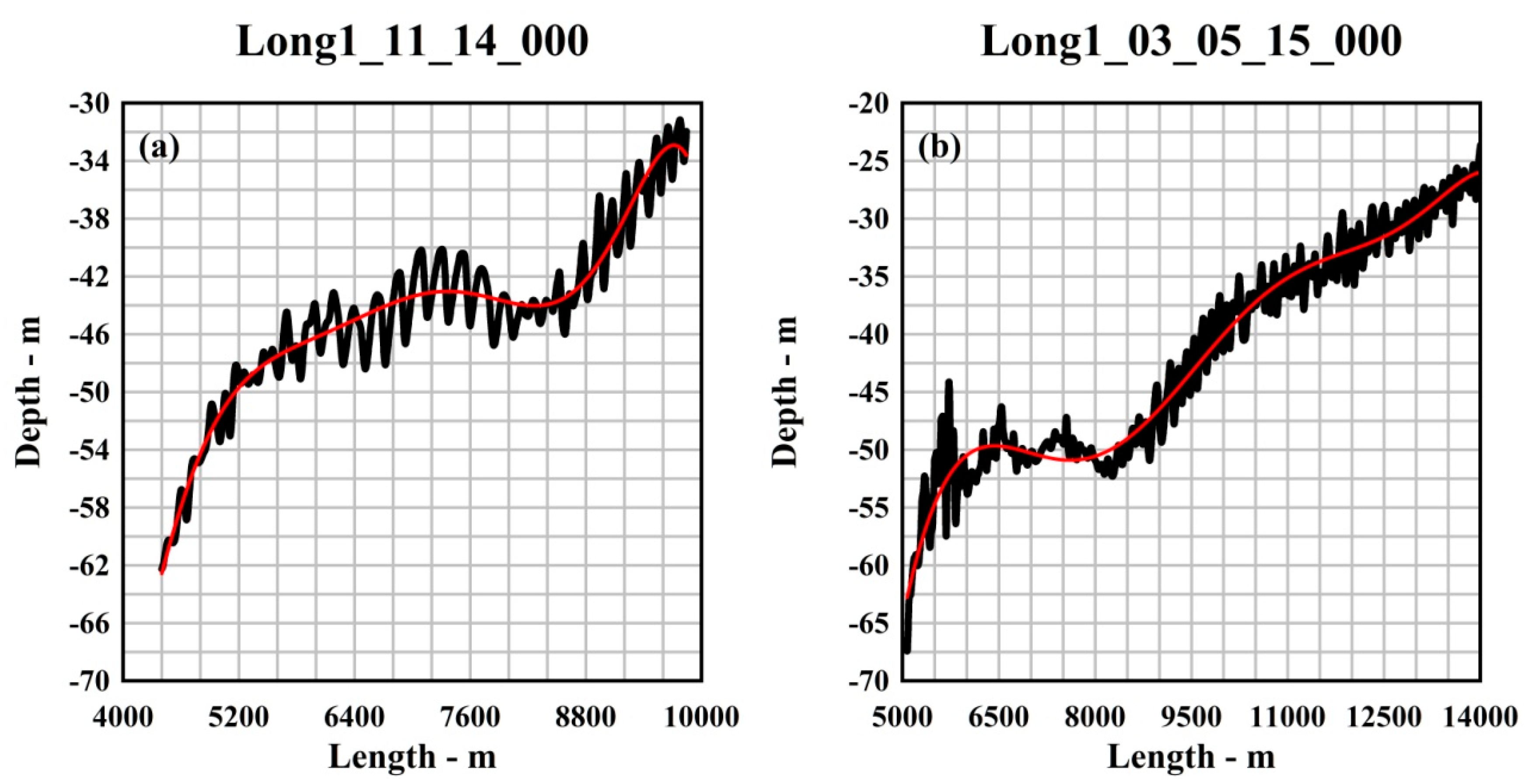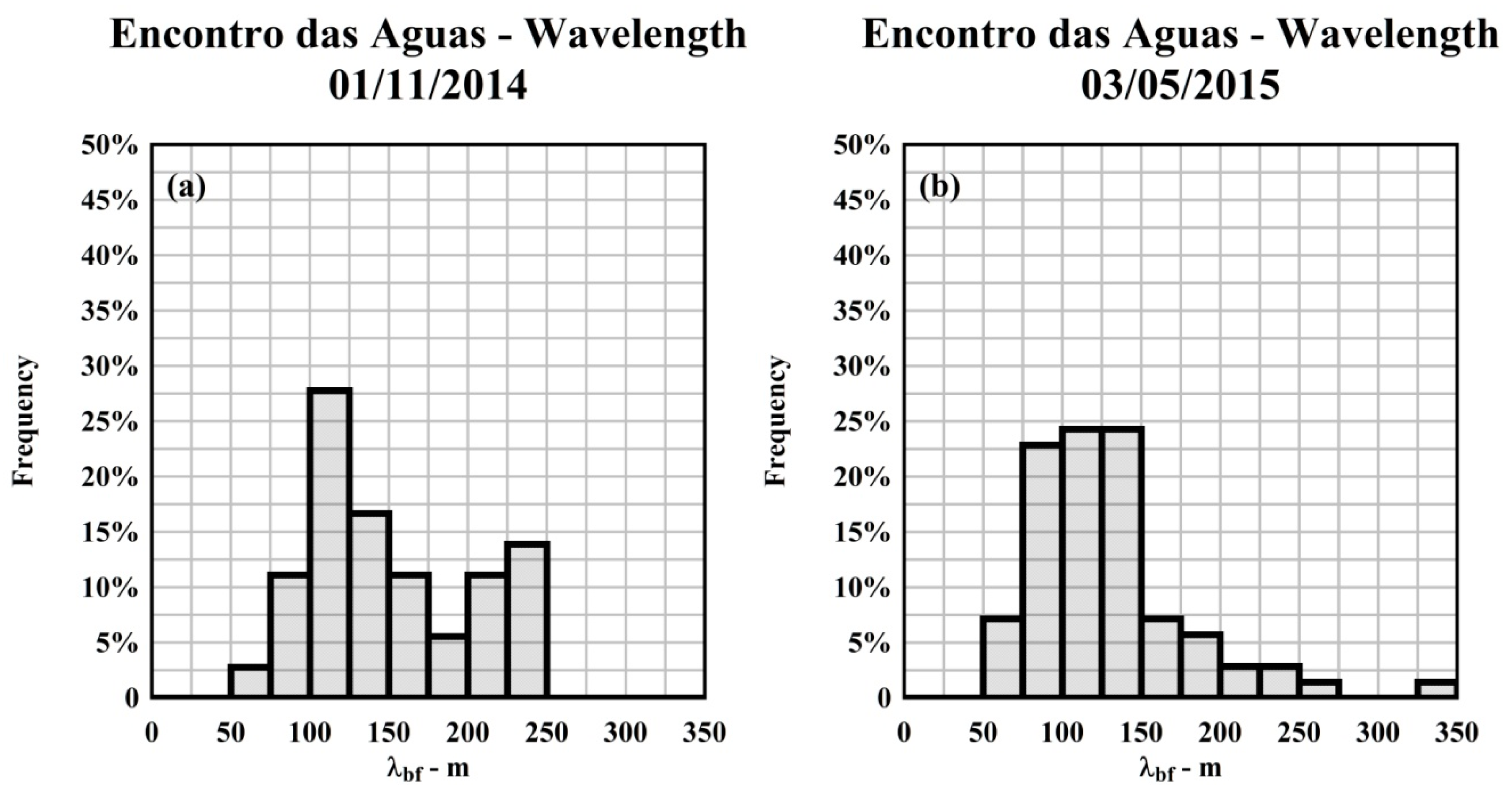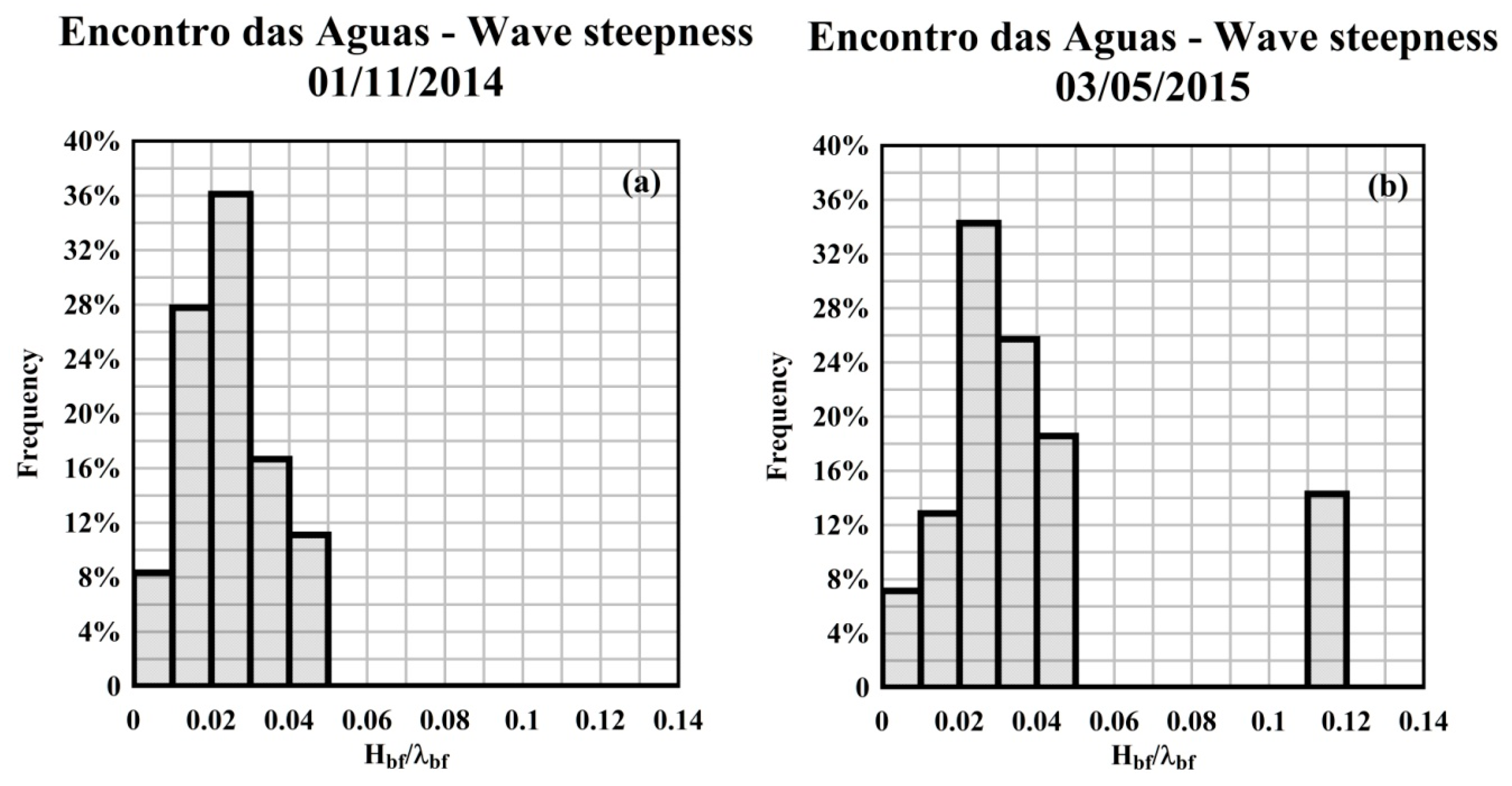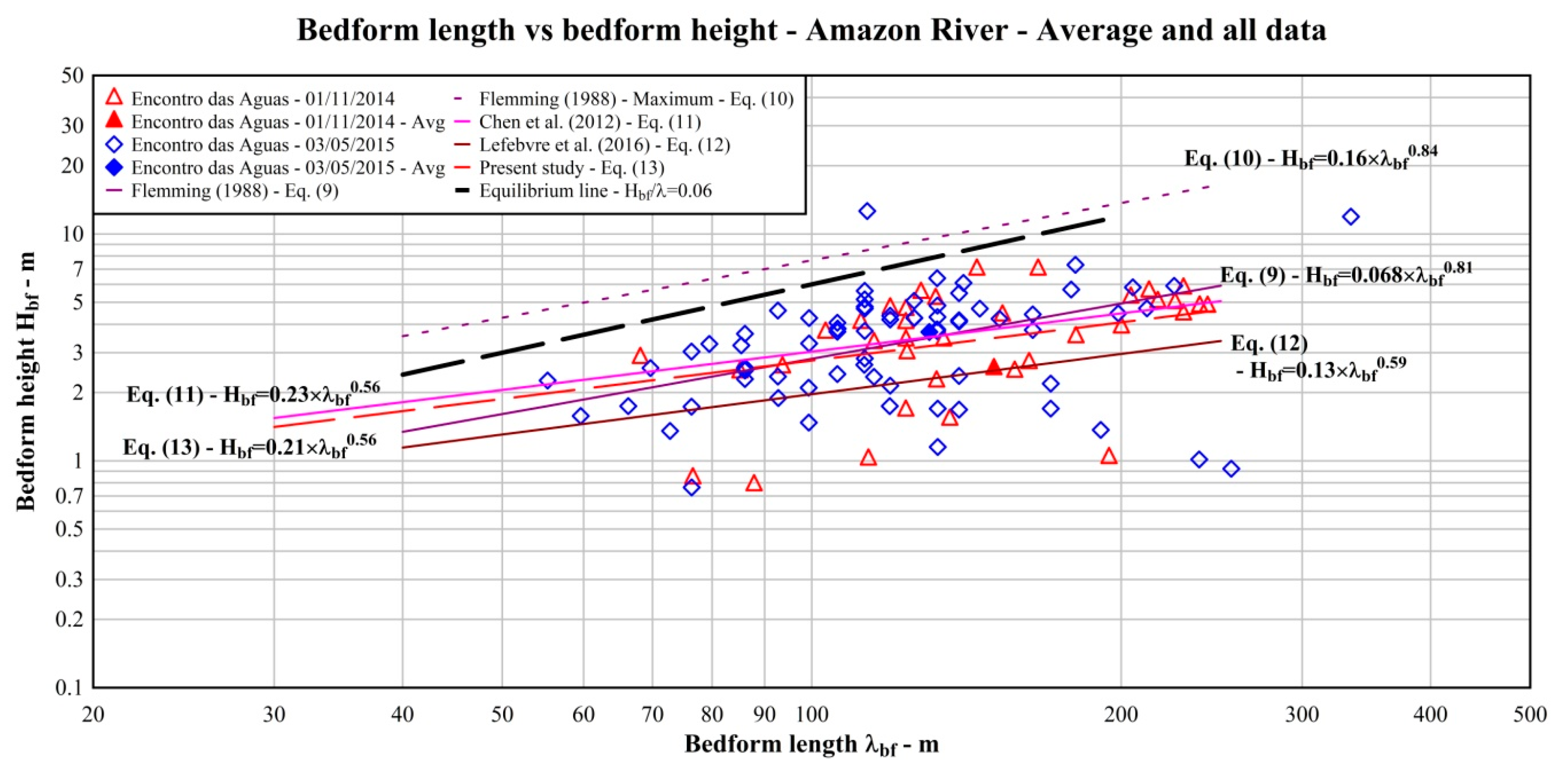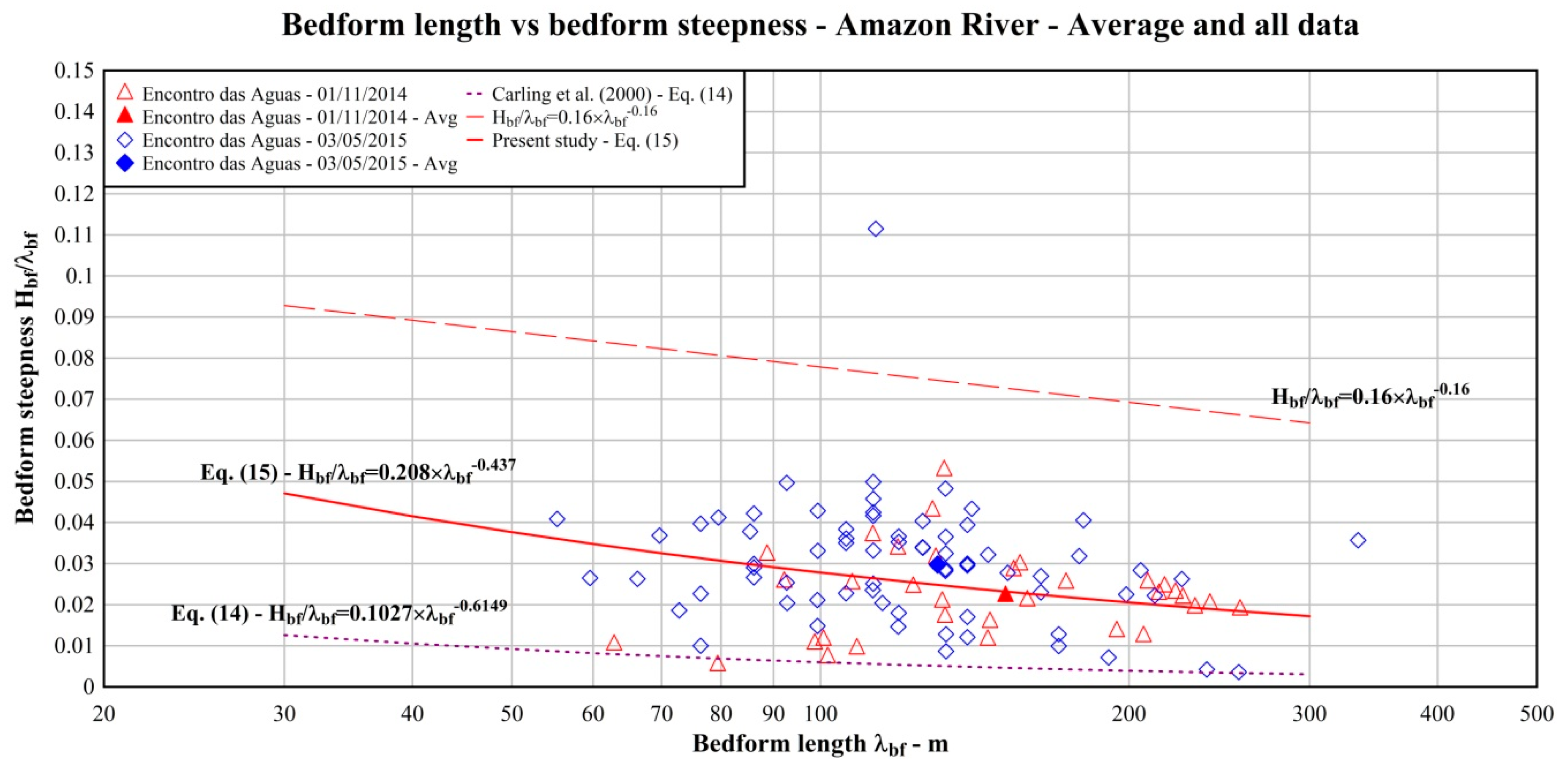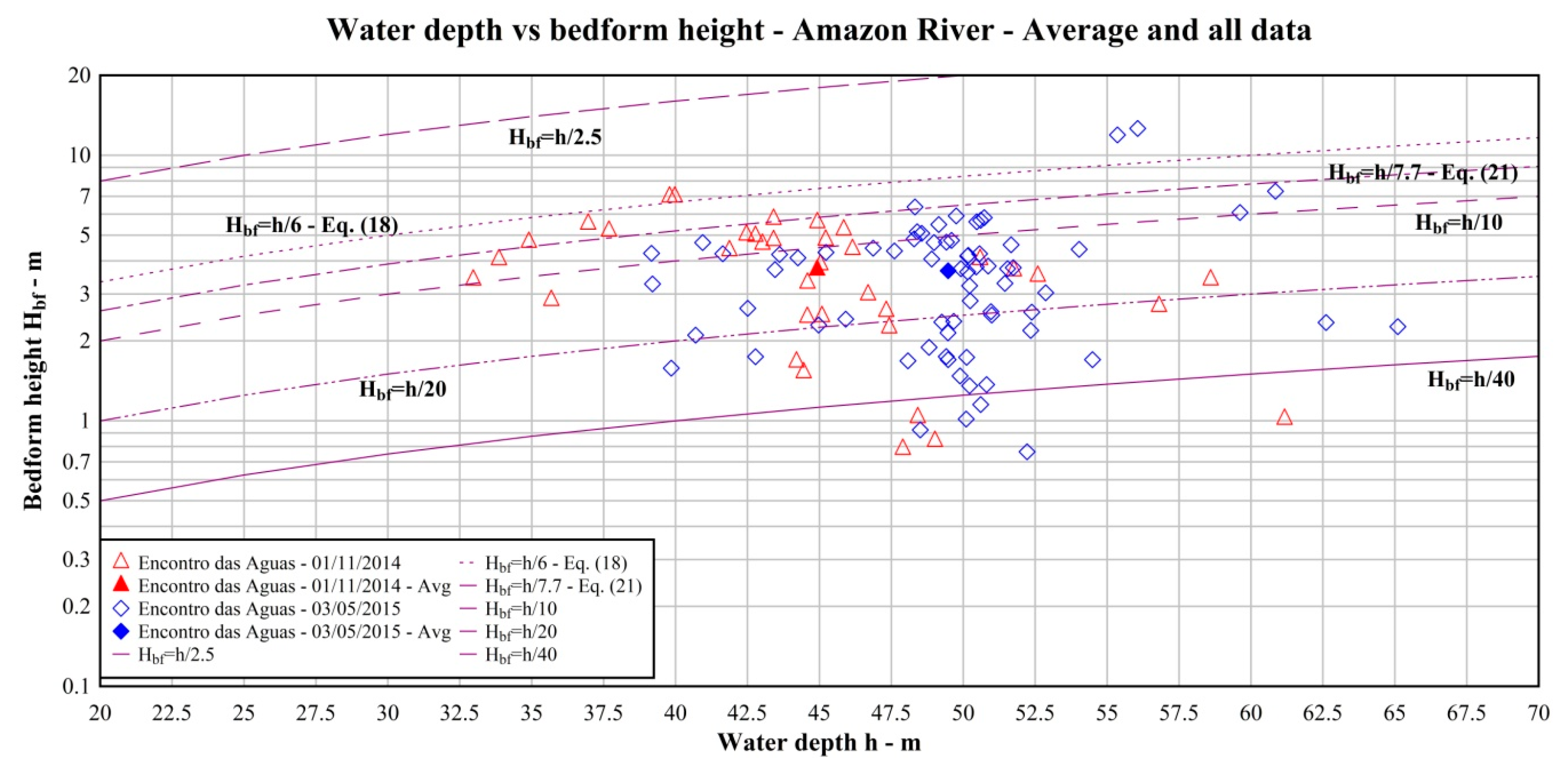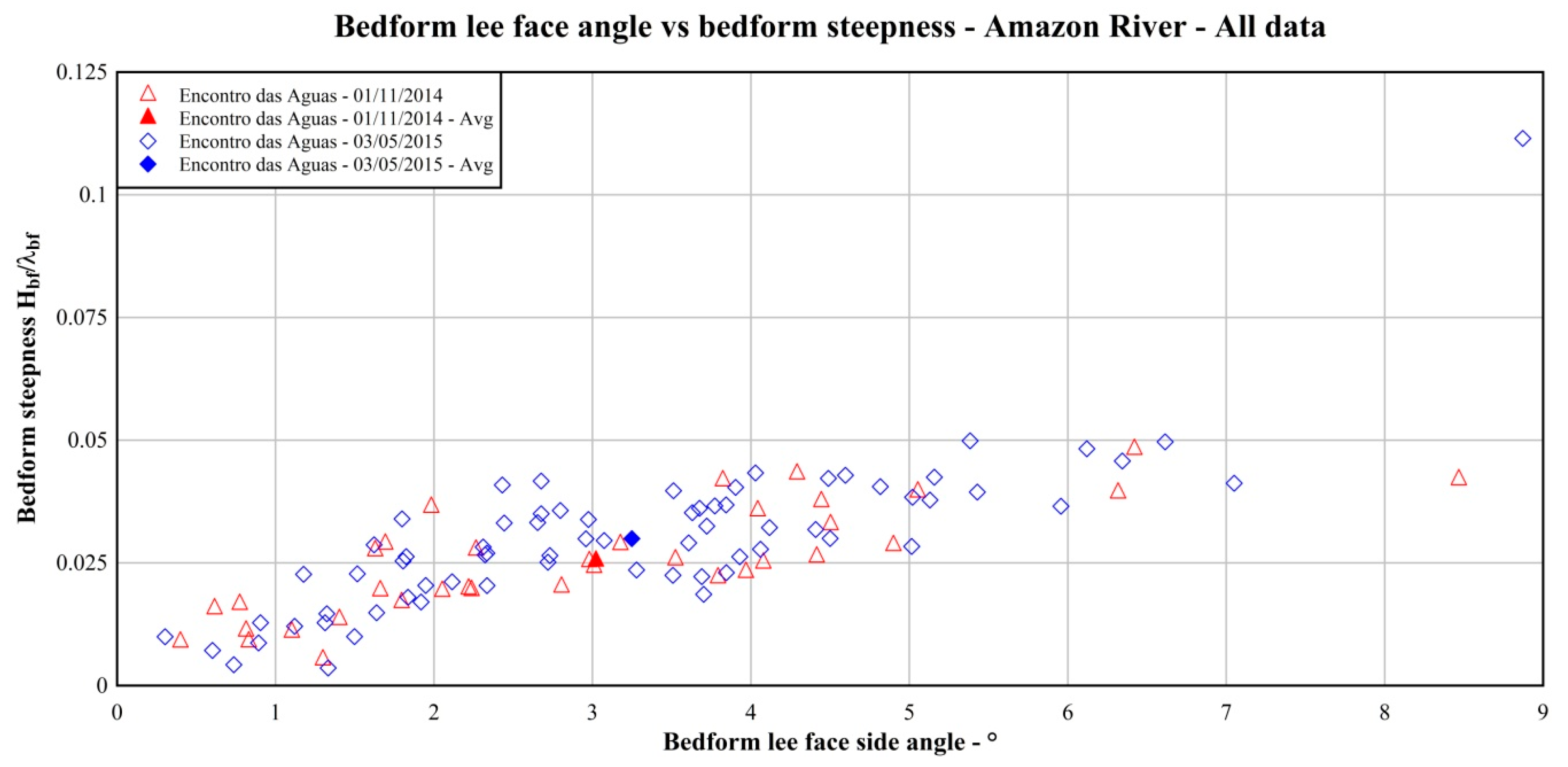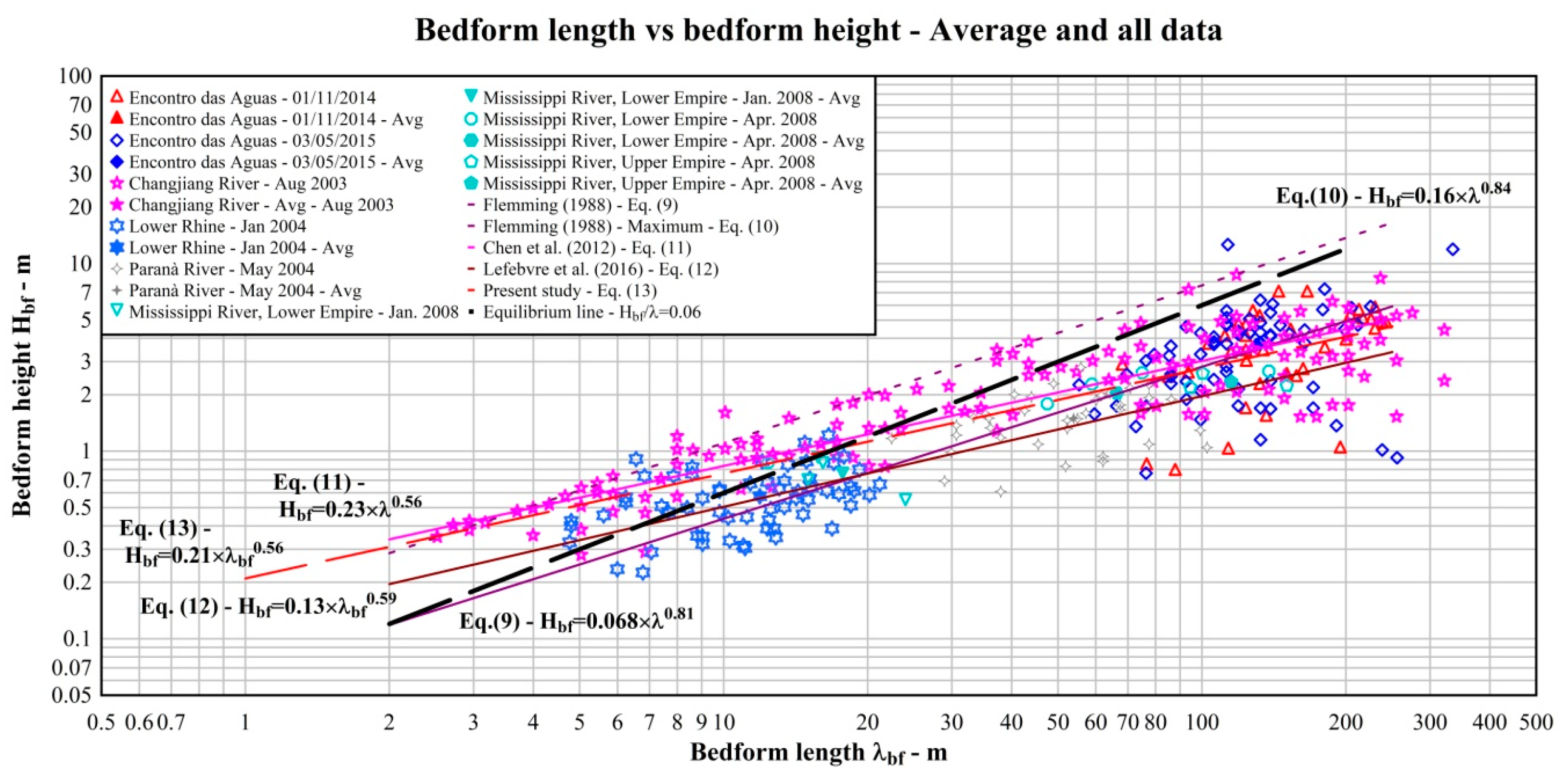3.1. Hydrodynamics and Sediment Transport Parameters along the Longitudinal Transects. Results
The location and length of the two longitudinal transects collected in the area of the confluence during FS−CNS1 and FS−CNS2, approximately 900 m away from the Solimões/Amazon right bank, are presented in
Table 3 and
Figure 1.
The ADCP measurements provided data about water depth and velocity. The observed water depth ranged from 21 to 68 m, with an increase of about 6–7 m from low to relatively high flow conditions.
Table 4 lists the minimum, average, median and maximum value of the depth-averaged velocity along the ADCP transects as well as its standard deviation. No large variations were observed from low flow to relatively high flow conditions on minimum and average velocity, but the maximum depth-averaged velocity increased from 2.2 to 2.8 m/s.
Figure 5 and
Figure 6 show the longitudinal distribution of the depth-averaged velocity in the ADCP transects collected in FS−CNS1 and FS−CNS2, respectively.
Downstream from the mouth of the Solimões, the longitudinal transect was initially located on the rocky scour hole, with a depth larger than 60 m. After the scour hole, it was observed a wide sandstone terrace at depth of about 35 m, gently sloping downstream, followed by sharp 30 m decrease in depth. Downstream of this large depression, the bedforms were found [
43]. The starting point of the bedforms is located within the flow recovery region, where the Amazon channel is widening, at approximately 4.7 km downstream of the confluence junction. Interestingly, the bedform size seems to increase and the shape changes with downstream distance.
Some parameters related to sediment transport were calculated. In alluvial channels, friction is related both to the grain resistance and to the form of bedform and the total shear stress is [
2,
45]:
where
τ′b and
τ″b are the skin friction shear stress and the form-related shear stress, respectively.
The skin friction shear stress was calculated as [
46]:
where
Cd is the drag coefficient, which was obtained as:
where
κ is the von Kármán constant,
e is the Euler number and
z0 is the zero−velocity height above the bed, which can be obtained as [
47]:
where
d84 is bed grain diameter such that 84% of diameters are finer (
Figure 7) [
48]. The water density was calculated from the temperature
T as:
The form-related shear stress was computed as [
2]:
where
Hbf and
Lbf are bedforms height and length, respectively, and
h is water depth.
Table 5 lists the minimum, average, standard deviation, median and maximum value of the bed shear stress along the ADCP transects calculated using Equation (1). No large variations were observed in the median value from low to relatively high flow conditions. Finally, the shear stress allows us to calculate the maximum suspended grain size
dss [
49]:
where
ρs is the particle density, and
ν is the water kinematic viscosity, that was calculated as:
Table 6 lists the minimum, average, standard deviation, median and maximum value of the maximum suspended grain size along the ADCP transects calculated using Equation (7). The maximum suspended grain sizes were generally in the order of fine sand (0.125−0.250 mm) with a highest value in the range of medium sand (0.250−0.500 mm) in both flow conditions.
3.2. Bedform Morphology. Results and Discussion
Bedform characteristics were derived through several steps. The raw ADCP data were first extracted with WinRiver II. Then, the ADCP data were processed to get depth-averaged vertical and streamwise velocities according to the procedure described in Bahmanpouri et al. [
50] with the addition of a further low-pass filtering to remove spikes and noise. The next stage was to track the bottom profile to detect the bedforms as anomaly relative to a reference depth. To this aim, a Matlab code was implemented: a seventh-grade polynomial fit curve was chosen (
Figure 8) to define a reference depth used to detect using visual analysis individual bedforms as a succession of trough–crest–trough and to estimate their wavelength and wave height. Using this procedure, further metrics such as wave steepness, lee side and stoss side lengths and angles were calculated.
Table 7,
Table 8 and
Table 9 list the minimum, average, median and maximum value of the wavelength
λbf, wave height
Hbf and wave steepness
Hbf/
λbf as well as their standard deviation for the bedforms observed during this study. The datasets for FS−CNS1 and FS−CNS2 were termed “Encontro das Aguas—1 November 2014” and “Encontro das Aguas—3 May 2015”, respectively.
Figure 9,
Figure 10 and
Figure 11 show the frequency distribution for these parameters. For each parameter 14 classes in size were considered. The 2D analysis identified 36 and 70 bedforms, which were all classified from
Table 1 [
22] at least as
large dunes (
λbf > 10 m), while
very large dunes (
λbf > 100 m) were 86% and 70%, in FS−CNS1 and FS−CNS2, respectively. The minimum wavelength
λbf was equal to 55 m, observed in the FS−CNS2. The maximum wavelength was found in relatively high flow conditions and it was longer than 330 m. On average, the wavelength
λbf was 150 and 128 m for FS−CNS1 and FS−CNS2, respectively, while the average wave height
Hbf was 3.7 m in both cases. The average steepness
Hbf/
λbf was of 2.5% and 3.0% for FS−CNS1 and FS−CNS2, respectively. The distribution of the wavelength of the observed bedforms had a small percentage (14% and 30%) of bedforms shorter than 100 m.
The lee side angle was constantly below 10°, with a maximum value of 8.47° and 8.87° and an average value of 3.02° and 3.25°, in FS−CNS1 and FS−CNS2, respectively. These values are generally consistent with those from large rivers where low-angle (<10°) lee-side slopes are predominant [
15]. The asymmetry, defined as the ratio of stoss side length to the bedform length, was on average 0.56 and 0.47 in FS−CNS1 and FS−CNS2, respectively.
In the rising stage from October 2014 (FS−CNS1) to April/May 2015 (FS−CNS2), on average, the wavelength decreased, the steepness increased and the wave height remained unchanged, while the maximum sizes increased. Furthermore, a comparison between the frequency distribution of bedform size in low and relatively high flow conditions showed an increase in wavelength and wave height as the river discharge increased, in agreement with the past literature studies (
Figure 9,
Figure 10 and
Figure 11). However, as the two ADCP transects are different in length of about 4 km and have a different number of bedforms, the comparison was repeated considering only the bedforms located on the same reach of the two longitudinal transects. The results confirmed the above findings. At the end, the bedforms observed in this study were generally characterised by large wavelengths, ranging from 55 to 335 m, with a median value of 133 and 120 m, respectively, and wave height on average larger than 3 m. The wave steepness was in the range from 0.3% to 11%.
3.3. Modeling Bedforms Morphology. A Comparison with Predictive Equations. Discussion
As already pointed out, dune development is related to both their deformation during migration and their adaptation to flow variations [
9]. Dune adaptation has been extensively investigated as an important process in river morphodynamics, but there is not yet a universal model to predict changes in dune sizes in response to flow variations. This morphological response has been often related to sediment mobility, which itself is a product of flow depth and velocity [
9], and dune size has been related to flow depth as a result of interaction between large eddies in the flow and the sediment bed [
17,
51,
52], Bedform wavelength was plotted versus bedform wave height [
13,
20,
26,
53] and the data were compared with the empirical relationships proposed by Flemming, which were based on 1491 deep sea, tidal and river bedforms [
22]:
where Equation (9) represents a range of steepness
Hbf/
λbf from 0.08 to 0.1 [
20].
Figure 12 shows the results for the bedforms observed in the field surveys, including their respective averages. The data were also compared with the equation proposed by Chen et al. [
13] using experimental data collected in the middle–lower Changjiang (Yangtze) River (China):
Furthermore, the equation proposed by Lefebvre et al. [
53], who used the data from the Rio Paranà (Argentina) [
12] and those from the Lower Rhine (the Netherlands) [
54], was included:
Using the data from the two field surveys, it was possible to derive a new regression equation:
which is very close to Equation (11). Furthermore, theory and laboratory studies in uniform and steady flow suggest that dunes with a steepness
Hbf/
λbf less than 0.06 are either non-equilibrium bedforms or represent an equilibrium adjustment of the bed form, in which maximum steepness is precluded by hydraulic constraints, notably a depth limitation [
20]. The equilibrium line corresponding to
Hbf/
λbf = 0.06 was also included in
Figure 12. All the bedforms, but one, were below Flemming’s maximum line (Equation (10)). Only some of
large dunes (10.0 >
λbf > 100 m) were well aligned between Equation (11) and Equation (9) and close to the equilibrium line, while in many cases they showed a large scatter from these lines. On the other hand, most of the
very large dunes (
λbf > 100 m) were well aligned with both Chen et al. [
13] (Equation (11)) and Flemming’s (Equation (9)) lines and close to the equilibrium line, but several bedforms from FS−CNS2 and also a number from FS−CNS1 had a low wave height, corresponding to a steepness in the order of 0.01–0.02, so they may represent bedforms in adaptation. It is worth noting that during FS-CNS1, the longitudinal transect was collected after seven days of near-constant low-flow discharges, while FS-CNS2 was conducted during a period of continuously rising flow discharges. This could explain why the dune field may have mostly obtained a stable equilibrium with the flow conditions during FS-CNS1, while dune field was in a transitional phase during FS-CNS2 as it adjusted to the increasing flow discharge.
The length of the bedforms observed in the three field surveys were plotted against their steepness
Hbf/
λbf in
Figure 13 and compared with the relationship proposed by Carling et al. [
20]:
and a new regression equation was derived:
Several bedforms, in both flow conditions, were characterised from steepness in the order of 0.01–0.2. This indicates that the bedforms with low steepness observed in FS−CNS2 were developing with the increasing discharge, while, on the other side, those in FS−CNS1 were in the process of crest flattening and elongation, having been formed during the previous high flow conditions [
13].
As already mentioned above, dune sizes are often thought to scale with flow depth [
10,
11,
17,
26,
51,
52,
55], as developing dunes cannot emerge out of the water [
26], but, in the literature, other scaling relationships based on depth and grain size [
24], transport stage [
23,
56] and transport stage and Froude number [
57] were proposed. Transport stage is generally defined as any metric that is composed of a ratio of the shear stress to a grain size [
25,
26], including the Shields number and the Rouse number, which is defined as:
where
ws is particle settling velocity and
u* is the shear velocity, which can be obtained from the total bed shear stress
τb as
u* = (
τb/
ρ)
0.5. The most widely applied scaling equation for dune size is that of Yalin [
51], where bedform wavelength and wave height are related to the flow depth as:
while Yalin [
52] suggested a theoretical value of
λbf = 5
h for equilibrium dunes in deep flows. Venditti [
55] analyzed Allen’s [
58] dataset and identified a range of variability between
h and 16
h for bedform length and between 1/40
h and 1/6
h for the bedform height. He also argued that the reason for this variability is that bedform sizes are dependent on transport stage and lag changes in the flow conditions.
Bradley and Venditti [
26] re-evaluated seven predictive equations, including those from Yalin, linking dune dimensions to other variables such as flow depth, grain size, transport stage and Froude number. The data compilation using 498 observations coming from 21 flume experiments and 20 field studies shows that dune height and length follow a power law:
which is very similar to Flemming’s equation (Equation (9)). Most of the data for bedform length and height were ranging from
h to 16
h and from
h/20 to
h/2.5, respectively. Bradley and Venditti [
26] found that the predictive power of all the scaling relations was generally poor probably because these relations are not able to capture any effect of the flow variability over the time. They also observed that dunes in smaller channels conform to a different height scaling than dunes in larger channels, which reflects a change in dune morphology from strongly asymmetric dunes with high lee angles in flows <2.5 m deep to more symmetric, lower lee angle dunes in flows >2.5 m deep [
26]. This implies a different process control rather than a continuum of processes as depth increases [
26]. Hence, from the analysis of only data in channels with depth
h > 2.5 m, they derived two different equations for wave height, a linear regression equation and a non-parametric scaling equation:
while, for all the data, they derived for wavelength again a linear regression equation and a non-parametric scaling equation:
Bradley and Venditti [
26] recommended to apply non-parametric scaling relations, i.e., Equations (21) and (23), concluding that if it is clear that dunes increase its sizes with the scale of the river system, a sound explanation for how flow depth rules the equilibrium sizes of dunes is still lacking. Rather, the apparent scaling of dunes with flow depth may be only indirect and emerge because shear stress/velocity, both depending on depth, play a key role in dune morphology [
26].
Figure 14 and
Figure 15 present the relationship between water depth and bedform wavelength and wave height, respectively, for the dunes observed in this study. The data were not exceeding the upper limits of scaling reported by [
55]. On the other hand, while length data were quite well aligned between the curves for
λbf = 5.9
h (Equation (23)) and
λbf = h (
Figure 14), height data ranged mostly from
Hbf = h/6 to
Hbf = h/40, with some values above and below these curves (
Figure 15). The bedforms with low wave height, i.e.,
Hbf <
h/20 or
Hbf <
h/40, observed mostly in FS−CNS2 were probably adapting to the raising stage to high flow conditions. Finally, most of the wave height data were below the curve for
h/10, confirming the findings observed in large rivers where height is often only 10% of the local flow depth [
15].
Bedform sizes were also related to the transport stage expressed by the suspension number
u*/
ws [
25], which is the inverse of the Rouse number (Equation (15)) multiplied by the von Kármán constant.
Figure 16 presents the distribution of the relative bedform wavelength
λbf/
h and wave height
Hbf/
h against the suspension number
u*/
ws, being in both flow conditions, in the range from 0.3 to 0.6. The lee side angle was below 10°, with an average value of 3.02° and 3.25° in 2014 and 2015 surveys, respectively. Lee side angles showed an interesting relationship to wave steepness (
Figure 17). Bedform steepness grew gently with lee side angle and became constant above 6° at
Hbf/
λbf = 0.05, suggesting an interrelation between these parameters in this case [
53]. Finally, the analysis of vertical velocity measured in the ADCP transects showed no flow separation due to the low lee side angles, as reported in past studies on low-angle dunes [
1,
15,
59].
